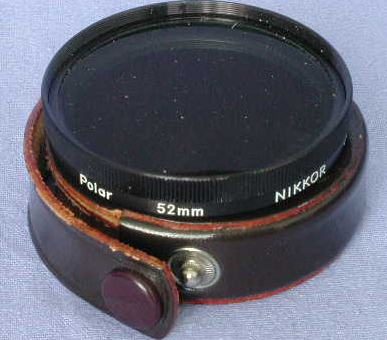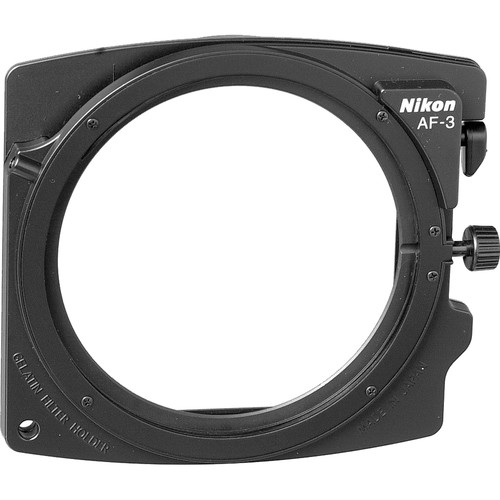Nikon filters
Since Nikon introduced its first lenses for cameras it also produced filters to be used on those lenses. Nikon filters are made of optical glass, ground and polished so that both surfaces are optically flat and parallel. They are spring mounted in their frames to eliminate strain. The first filters (1948-1967) had a chrome ring; since 1967 the filter ring is black. All filters are anti-reflection coated on both sides as per 1970. Nikon filters are available in screw-in mounts; many years ago they were also sold in so called Series mounts (IX-series as drop in filters for the use on e.g. the Zoom-Nikkors 85-250mm. and 200-600mm.). In 1995 Nikon introduced NC-filters. Filters can be divided in three main categories: - correction filters: for the correction of the wavelength of the light entering a lens - protection filters: to protect the front lens - effect filters: to give a special effect to an image
Most filters were available in screw mounts from 15 mm. up to 122 mm. For lenses to be used on Nikon rangefinder cameras (S-mount) filters were supplied in 34.5, 40.5, 43, 48, 52 and 62 and 110 (drop-in) mm. For Nikkorex movie cameras filters were available in the sizes 15, 22.5, 34.5, 40.5 and 52 mm. For most SLR-lenses filters are (still) available in 39, 52, 58, 62, 72, 77, 82, 95 and 122 mm. screw mount. (Check your dealer which filters are available!) All screw mount filters have a male and female mount to accept hoods and/or other accessories. In its early years Nikon gave all filters a chrome frame, nowadays all filters are supplied in black frames. Note A: filters do not improve the optical performance of bad lenses; as the diameter and thickness of a filter have an influence on the degree of vignetting, use only one filter at a time. Note B: nearly all odern long tele-Nikkors (300mm+) have a special filter holder (Nikon CP-L) that slides into the lens body. Apart form filters with a normal thread (e.g. 52 mm.) there are also gelatine filter holders. Most Nikon filters have an engraving referring to its function, filter factor and wavelength (in mµ). Nikon made filters to cut off wavelengths ranging from 300-950 mµ (nanometer). Example: L37 means that this filter absorbs ultraviolet light shorter than 370 mµ in wavelength. The ´C´ engraved in later versions refers to Nikon Super Integrated Coating. Many filters were designed to correct colors when film was used. Digital cameras do not need to use most correction filters as images can be corrected either with the camera´s software or with the various imaging/computer software. Skylight and UV-filters can be used - however - as protection filters in all circumstances. The filter or exposure factor given below means that the exposure, metered without a filter, should be increased by the factor mentioned. Not all cameras, especially digital cameras, will meter correctly as they have filters in front of the sensor cutting off certain wavelengths. Infrared photography is only feasible with film cameras using infrared film and certain digital cameras, like the Nikon D70. The Nikon D1 and D2 series and the Nikon D100 are fitted with filters that block infrared light. To check whether a digital camera can be used for infrared photography is to point an infrared remote device (e.g. of a TV set) at the sensor. If a light dot appears in the image the sensor may be sensible for infrared light. If nothing appears the sensor has an infrared filter in front of it.
Below a short description of filters, its Nikon designation, its use and - if relevant - its exposure factor.
Skylight - L1A, L1BC Outdoor photos taken with color film (especially Kodak films) have an unnatural bluish cast. These filters subdue the effect of blue to produce a more natural effect. They also help to cut haze. Ultraviolet - L37C, L39 Both filters completely cut out ultraviolet light invisible to the naked eye. The L37 cuts out haze and absorbs UV-light shorter than 370 mµ in wavelength, while the L39 cuts out wavelength shorter than 390 mµ. The latter was specially designed for black & white photography. Both filters may remain on any lens for protection. Yellow - Y44, Y48 and Y52 These lenses can be used for black & white photography only. They absorb moderately ultraviolet, violet and blue light for darkening skies and making clouds stand out. Light yellow filters (Y44) are suitable for outdoor portraits as they produce a more natural rendering of skin tones. As the filter factor increases, the color deepens and the effect becomes more pronounced. Filter/exposure factors are: Y44 = 1.5; Y48 = 1.7; Y52 = 2. Orange - O56 Also to be used in black & white photography only, this filter has a wider absorption range than yellow filters for more pronounced contrast. It accentuates any subject in which yellow, orange or red predominates. Filter factor is 2 - 3.5. Red - R60 This filter should be used with black & white films or infrared films. It creates a strong contrast, brings out distant scenes and can be used to create a night-time effect by underexposing. Filter factor is 5 or 6. Green - X0, X1 Used in black & white photography both filters are absorbing ultraviolet, blue and red, either partially or completely. The color balance of the subject must be considered carefully because of the filter´s tendency to cut out both blue and red simultaneously. Suitable for portraits and general photography. Filter factor is 2 - 5. Polarizing - Polar Nikon only produces circular polarizing filters (46, 52, 62, 72 and 77mm and drop-in only), to be used in black & white and color photography. They are eliminating various degrees of reflected light from glass, water, snow, tile and similar surfaces. Not effective for metal surfaces because the polarization is imperceptible. May be used in stead of an UV-filter + hood. Useful for photographing through glass windows (e.g. museums) or underwater. May give strong vignetting when used on digital cameras. Filter factor is 2 - 4. Neutral density - ND4X, ND8X, ND10X, ND400X / ND2S, ND4, ND4S, ND8S, ND400 These filters (X = older versions) can be used in black & white photography and color (film & digital) photography. The filters subdue all colors uniformly. Very useful for photographing extremely bright subjects like light sources or when a (fast) lens is used at a large aperture to minimize depth of field. Filter factor equal to its engraving. Note: To make pictures of the sun a so called Baader AstroSolar (tin)foil filter should be used, rather than a density filter! This filter has an optical density of 5 and a filter factor (stopping/curbing transparency) of 1:100,000 (= 0.001 %). Before pointing & focusing at the sun be sure that the right filter is mounted. Uncovered pointing at the sun damage your camera, lens and your eyes irreparable!!!! Amber - A2, A12 Amber may be used with daylight film to avoid the blue ting which likely to occur when a picture is taken in the shade. Especially when tungsten films (for indoor photography) are used outdoors. Filter factor is 1.2 - 2. Blue - B2, B8, B12 These filters may be used when a daylight film is used indoors with flash bulbs or photo-flood lamps. The B2 can also be used outdoors just before sunset or just after sunrise. Filter factor is 1.2 - 2.2. Neutral - NC Since 1995 Nikon introduced neutral filters for protection use only. These filters - available in 39, 46, 52, 62, 72 and 77 mm. - have no effect on the color balance. They are all multi-coated to avoid reflections. It is highly advisable to use these lenses for protection. A broken filter is cheaper than a new front lens! Filter factor is zero! Soft Focus Filter No.1, No. 2 These filters are softening images without influencing colors or depth of field. Very interesting for portraits or product photography. Filter factor is negligibly. Gelatine filter holderGel(atine) color filters (mostly transparent) are used in photography to color light or to correct colors. Modern gels are thin sheets of polycarbonate or polyester. However: Gels have a limited life, especially in saturated colors (lower light transmission) and shorter wavelength (blues). The color will fade or even melt, depending upon the energy absorption of the color, and the sheet will have to be replaced.
Nikon produced gelatine filter holders and gave them the AF code. The AF-1 is for filters with a thread of 52mm, the AF-2 has a 72 mm thread, the AF-3 can be mounted directly on any lens body with a diameter of 52-77 mm., the AF-4 has a thread of 39 mm.
|

